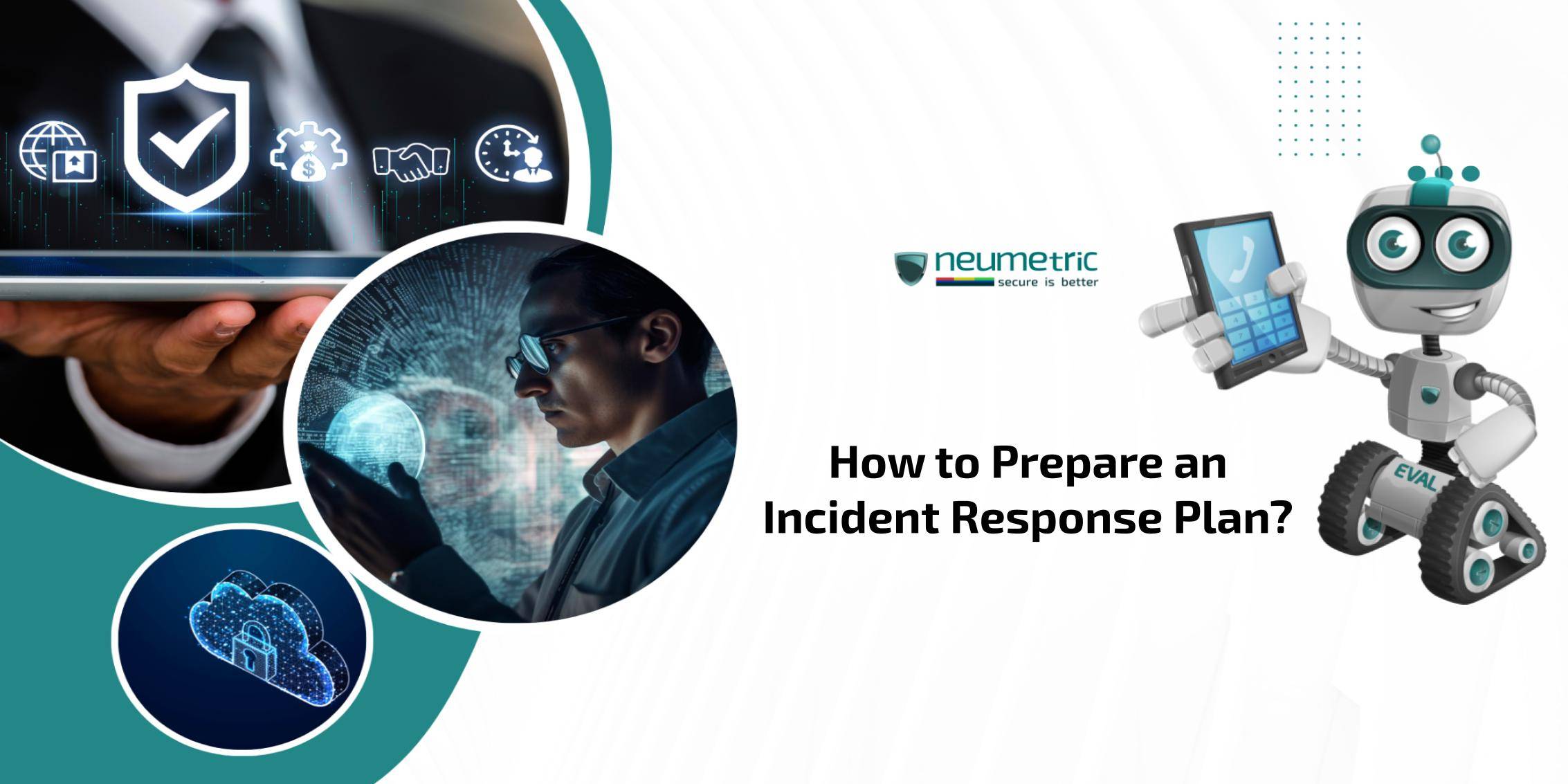Table of Contents
ToggleHow to Prepare an Incident Response Plan?
Introduction
Incident response plans are crucial for any organization, regardless of its size or industry. They provide a structured approach to managing & mitigating security incidents, ranging from cyberattacks to natural disasters. In this journal, we’ll delve into the essential steps involved in preparing an effective incident response plan & discuss the importance of being well-prepared for unexpected events.
Understanding Incident Response Plans
An incident response plan is a documented set of procedures aimed at minimizing the damage caused by security breaches or other unforeseen incidents. It outlines the steps to be taken in the event of an incident, including who is responsible for what actions & how communication will be managed.
Having a structured incident response plan is crucial for several reasons. It helps organizations respond promptly & effectively to incidents, reduces the impact of disruptions & ensures a coordinated approach among team members. Moreover, it demonstrates a commitment to security & compliance, which is essential for maintaining customer trust & meeting regulatory requirements.
Key Components of an Incident Response Plan
- Identification & Categorization of Potential Incidents
The first & arguably most crucial step in preparing an incident response plan is the thorough identification & categorization of potential incidents. This phase involves a comprehensive assessment of the various threats & vulnerabilities faced by the organization. By analyzing historical data, conducting risk assessments & staying informed about emerging threats, organizations can gain insights into the types of incidents they may encounter. These incidents can range from cyberattacks & data breaches to physical security breaches & natural disasters.
Once potential incidents have been identified, they must be categorized based on their severity & impact on operations. This categorization helps prioritize response efforts & allocate resources effectively. Incidents may be classified into different categories, such as critical, high, medium & low severity, depending on their potential impact on the organization’s operations, data & reputation.
- Roles & Responsibilities of Team Members
Clear & well-defined roles & responsibilities are essential for ensuring a coordinated & effective response to incidents. Each member of the incident response team should understand their role & responsibilities in the event of an incident. This includes designating individuals to lead the response effort, such as an incident commander or team leader, who will be responsible for coordinating the response & making key decisions.
In addition to leadership roles, team members should be assigned specific tasks & actions based on their skills & expertise. This may include roles such as technical analysts, legal advisors, communications specialists & liaison officers. By clearly defining roles & responsibilities, organizations can ensure that response efforts are well-coordinated & efficient, minimizing the impact of incidents on operations & data.
- Communication Protocols
Effective communication is essential during incident response to ensure that relevant information is shared promptly & accurately among team members & stakeholders. Organizations should establish clear communication protocols outlining how incidents will be reported, who needs to be notified & how information will be disseminated throughout the organization.
Communication protocols should include guidelines for reporting incidents, such as designated contact points & incident reporting forms. They should also specify the channels & methods of communication to be used, such as email, phone calls or messaging platforms. Additionally, communication protocols should outline escalation procedures for escalating incidents to higher levels of management or external stakeholders as necessary.
- Incident Detection & Reporting Procedures
Prompt detection & reporting of incidents are critical for minimizing their impact & facilitating a rapid response. Organizations should implement tools & processes for detecting & reporting incidents, such as Intrusion Detection Systems [IDS], Security Information & Event Management [SIEM] systems & incident reporting forms.
Detection tools & systems should be configured to monitor network traffic, system logs & other sources of data for signs of suspicious or malicious activity. Procedures for reporting incidents should specify what should happen when one is discovered, who to notify, how to report the occurrence & what details go into the report. By establishing robust detection & reporting procedures, organizations can identify & respond to incidents more effectively, reducing the potential impact on operations & data.
Preparing for Incident Response
- Conducting Risk Assessments: Organizations should carry out thorough risk assessments to identify potential threats & weaknesses prior to creating an incident response strategy. This helps prioritize response efforts & allocate resources effectively.
- Establishing Response Objectives: Setting clear objectives for incident response is essential for guiding the response effort. These objectives should align with the organization’s overall business goals & prioritize the protection of critical assets & data.
- Creating a Response Team: Assembling a dedicated incident response team is critical for effectively managing incidents. This team should include individuals with diverse skills & expertise, including IT professionals, legal experts & communications specialists.
Developing the Plan
- Formulating the Plan Structure: The structure of the incident response plan should be logical & easy to follow. It should include detailed procedures for each phase of the response process, from initial detection to post-incident analysis.
- Defining Incident Severity Levels: Defining different severity levels for incidents helps prioritize response efforts & allocate resources accordingly. These severity levels should be based on the potential impact of the incident on the organization’s operations & data.
- Determining Response Actions for Each Level: For each severity level, organizations should define specific response actions & procedures. This may include steps for containing the incident, investigating the cause & restoring normal operations.
Testing & Training
- Importance of Testing the Plan: Regular testing of the incident response plan is essential for ensuring its effectiveness & identifying any weaknesses or gaps. This can be done through tabletop exercises, simulated attacks or full-scale drills.
- Types of Tests & Exercises: There are various types of tests & exercises that organizations can use to test their incident response plans, including walkthroughs, simulations & red team exercises. Each type has its own strengths & weaknesses & can provide valuable insights into the organization’s readiness to respond to incidents.
- Continuous Training for Team Members: In addition to testing the plan, organizations should provide ongoing training for incident response team members. This helps ensure that team members are familiar with their roles & responsibilities & are prepared to respond effectively to incidents as they arise.
Implementation & Execution
- Activation of the Plan: When an incident occurs, the incident response plan should be promptly activated. This involves notifying the appropriate team members, initiating response actions & coordinating efforts to contain & mitigate the incident.
- Coordination Among Team Members: Effective coordination among team members is critical during incident response. This includes regular communication, sharing of information & collaboration to ensure that response efforts are well-coordinated & efficient.
- Response to Different Types of Incidents: The response to incidents may vary depending on their nature & severity. Organizations should be prepared to respond to a wide range of incidents, including cyberattacks, natural disasters & physical security breaches.
Monitoring & Evaluation
- Continuous Monitoring of Systems: Continuous monitoring of systems & networks is essential for detecting & responding to incidents in a timely manner. This involves implementing monitoring tools & processes to identify abnormal activity & potential security threats.
- Reviewing Incident Response Procedures: After an incident has been resolved, it’s important to review the incident response procedures to identify any areas for improvement. This may involve conducting a post-incident analysis to determine what worked well & what could be done better in the future.
- Identifying Areas for Improvement: Based on the review of incident response procedures, organizations should identify areas for improvement & take steps to address them. This may involve updating the incident response plan, providing additional training for team members or implementing new tools & technologies.
Updating the Plan
- Regular Review & Revision: Incident response plans should be regularly reviewed & updated to reflect changes in the organization’s environment, such as new threats or vulnerabilities. This guarantees the plan’s continued relevance & efficacy throughout time.
- Incorporating Lessons Learned: Lessons learned from previous incidents should be incorporated into the incident response plan to improve future response efforts. This may include updating procedures, revising response objectives or implementing new controls to mitigate similar incidents in the future.
Benefits of Having an Incident Response Plan
- Minimizing Downtime & Data Loss: When a security incident occurs, every moment counts. Downtime & data loss can wreak havoc on an organization’s operations & reputation. A well-prepared incident response plan acts as a lifeline in such situations, allowing organizations to spring into action swiftly & decisively. By having predefined procedures & protocols in place, teams can respond to incidents promptly, minimizing the time it takes to identify, contain & mitigate the impact of the incident. This rapid response not only reduces the duration of downtime but also limits the amount of data that is compromised or lost during the incident. Whether it’s a cyberattack, a system failure or a natural disaster, an effective incident response plan serves as a shield, protecting the organization’s assets & ensuring continuity of operations.
- Enhancing Organization’s Resilience: In today’s rapidly evolving threat landscape, resilience is key to survival. Organizations must be prepared to weather storms, whether they come in the form of cyber threats, physical attacks or natural disasters. A structured incident response plan plays a pivotal role in enhancing an organization’s resilience by providing a roadmap for navigating through turbulent times. By proactively identifying potential threats & vulnerabilities, organizations can prepare themselves to respond effectively when incidents occur. Moreover, having clearly defined roles & responsibilities ensures that everyone knows what to do & how to contribute to the response effort. This coordinated approach strengthens the organization’s ability to withstand & recover from adverse events, minimizing the disruption to business operations & preserving its reputation & credibility in the eyes of customers, stakeholders & regulators.
- Meeting Regulatory Requirements: Fulfilling Requirements of Regulations Compliance is a must in a company climate that is becoming more & more regulated. Many regulatory frameworks, such as General Data Protection Regulation [GDPR], Health Insurance Portability and Accountability Act [HIPAA] & Payment Card Industry Data Security Standard [PCI DSS], mandate that organizations implement robust security measures to protect sensitive data & ensure the privacy & confidentiality of information. An incident response plan is a fundamental component of these compliance efforts. Regulatory authorities expect organizations to have a structured approach to managing security incidents, including clear procedures for detecting, reporting & responding to breaches. By having an incident response plan in place, organizations demonstrate their commitment to safeguarding data & complying with applicable regulations. This not only helps avoid hefty fines & penalties but also fosters trust & confidence among customers, partners & other stakeholders. Ultimately, meeting regulatory requirements is not just about avoiding legal consequences—it’s about upholding ethical standards & safeguarding the interests of those who entrust their data to the organization’s care.
Challenges & Considerations
Organizations encounter various challenges during the development & implementation of incident response plans. One of the most prevalent issues is resource constraints. Limited budgets & manpower can hinder the creation of robust response strategies & the acquisition of necessary tools & technologies. Additionally, organizations may face a lack of executive support, which can impede the prioritization of security initiatives & the allocation of resources to incident response efforts.
Another significant challenge is the evolving threats landscape. As cyber threats continually evolve & become more sophisticated, organizations must adapt their incident response plans to address new & emerging risks effectively.
Factors to Consider When Developing a Plan
Several factors must be taken into account when developing an incident response plan to ensure its effectiveness. Firstly, organizations need to consider the nature of their business. Industries vary significantly in terms of their operations, regulatory requirements & potential threats. Therefore, incident response plans should be tailored to address the specific needs & risks faced by each organization.
Additionally, organizations must assess the types of threats they are likely to encounter. This includes both internal & external threats, such as cyberattacks, natural disasters & human error. Understanding the potential sources of risk allows organizations to develop targeted response strategies. Finally, organizations should evaluate the resources available for response efforts. This includes not only financial resources but also personnel, technology & infrastructure.
Adequate resources are essential for executing an effective response plan & mitigating the impact of security incidents. By considering these factors, organizations can develop comprehensive incident response plans that are tailored to their unique circumstances & effectively address potential threats.
Conclusion
In conclusion, preparing an incident response plan is essential for organizations to effectively manage & mitigate security incidents. By following the steps outlined in this journal & incorporating best practices, organizations can enhance their resilience to threats & minimize the impact of incidents on their operations & data. It’s essential to remember that incident response is not a one-time activity but an ongoing process that requires continuous attention & improvement.
Frequently Asked Questions [FAQ]
What is the difference between an incident response plan & a business continuity plan?
An incident response plan focuses specifically on managing & mitigating security incidents, while a business continuity plan addresses broader continuity & resilience issues, including disruptions caused by natural disasters, pandemics & other unforeseen events.
How often should an incident response plan be tested & updated?
Incident response plans should be tested regularly, ideally at least once a year & updated whenever significant changes occur in the organization’s environment, such as changes in technology, threats or regulatory requirements.
Are there any industry-specific considerations when developing an incident response plan?
Yes, different industries may face unique threats & regulatory requirements that need to be taken into account when developing an incident response plan. For example, the healthcare industry may need to comply with Health Insurance Portability & Accountability Act [HIPAA] regulations, while financial institutions may need to adhere to Payment Card Industry Data Security Standard [PCI DSS] requirements.





